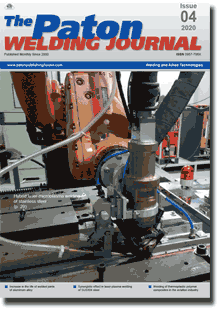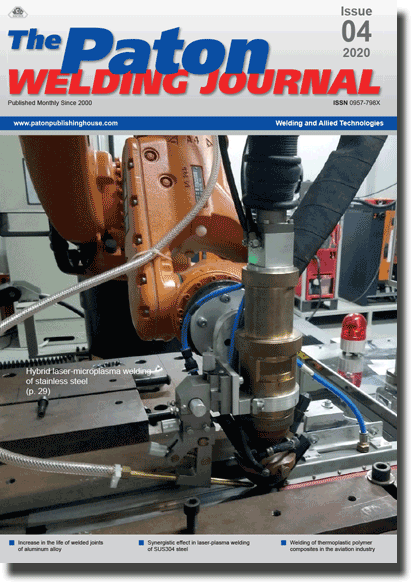| 2020 №04 (02) |
DOI of Article 10.37434/tpwj2020.04.03 |
2020 №04 (04) |

The Paton Welding Journal, 2020, #4, 19-24 pages
Impact of high-frequency peening and marine atmosphere on the cyclic life of t-welded joints with surface fatigue cracks
V.V. Knysh, S.O. Solovei, L.I. Nyrkova, V.G. Kot and A.O. Grishanov
E.O. Paton Electric Welding Institute of the NAS of Ukraine 11 Kazymyr Malevych Str., 03150, Kyiv, Ukraine. E-mail: office@paton.kiev.ua
Abstract
The results of investigations of the efficiency of application of high-frequency mechanical peening technology to increase the residual life of T-welded joints of 15KhSND steel with surface fatigue cracks of 2–20 mm length and corrosion damage typical for structures after long-term service in the conditions of marine climate are presented. The long-term impact of marine atmosphere, which is typical for coastal regions of Ukraine, on the state of the surface of joints, was simulated by exposure of the samples in the salt spray chamber KST-1 for 1200 h. It was shown that surface cracks and corrosion damage significantly reduce the residual cycle life of welded joints. It was experimentally found that HFMP strengthening of T-welded joints with surface fatigue cracks of 5–7 mm length (depth is up to 1.6 mm) and characteristic corrosion damage increases their residual cyclic life to the level of welded joints with corrosion damage, strengthened by high-frequency mechanical peening at the stage of manufacturing. It is shown that in the presence of fatigue cracks of 20 mm length (about 6 mm depth), their residual life is reduced by up to 10 times, and the use of high-frequency mechanical peeening technology for such joints does not increase the cyclic life and is ineffective. 14 Ref., 2 Tables, 5 Figures.
Keywords: T-welded joints, corrosive medium, fatigue, accelerated corrosion tests, salt spray, high-frequency mechanical peening, increase in cyclic life
Received 19.02.2020
References
1. Poja Shams-Hakimi, Farshid Zamiri, Mohammad AlEmrani, Zuheir Barsoum (2018) Experimental study of transverse attachment joints with 40 and 60mm thick main plates, improved by high-frequency mechanical impact treatment (HFMI). Engineering Structures, 155, 251-266. https://doi.org/10.1016/j.engstruct.2017.11.0352. Lefebvre, F., Peyrac, C., Elbel, G., et al. (2017) HFMI: Understanding the mechanisms for fatigue life improvement and repair of welded structures. Welding in the Word, 4, 789-799. https://doi.org/10.1007/s40194-017-0455-8
3. Abbasi, A., Amini, S., Sheikhzadeh, G.A. (2018) Effect of ultrasonic peening technology on the thermal fatigue of rolling mill rolls. The Int. J. of Advanced Manufacturing Technology, 5-8, 2499-2513. https://doi.org/10.1007/s00170-017-0840-x
4. Kudryavtsev, Y. ( 2018) Rehabilitation and repair of welded elements by ultrasonic peening. International Institute of Welding. IIW Document XIII-2076-05.13 p..
5. Harati, E., Swensson, L.E., Karlsson, L., Widmark, M. (2016) Effect of high frequency mechanical impact treatment on fatigue strength of welded 1300 MPa yield strength steel. Pt 1. Int. J. of Fatigue, 92(10), 96-106. https://doi.org/10.1016/j.ijfatigue.2016.06.019
6. Zhang, H., Wang, D., Deng, C. (2018) Optimal preparation process for fatigue specimens treated by ultrasonic peening. Experimental Techniques, 42(2), 199-207. https://doi.org/10.1007/s40799-017-0209-y
7. Takanori Deluchi, Masashi Mouri, Junya Hara, et al. (2012) Fatigue strength improvement for ship structures by ultrasonic peening. J. of Marine Sci. and Technology, 17(3), 360-369. https://doi.org/10.1007/s00773-012-0172-3
8. Fisher, J.W., Statnikov, E., Tehini, L. .(2002) Fatigue strength improvement of bridge girders by ultrasonic impact treatment (UIT). Welding in the World, 9-10, 34-40. https://doi.org/10.1007/BF03377347
9. Fikri Bashar Yalchiner, Zuheir Barsoum (2017) Life extension of welded structures using HFMI Techniques - potential application to offshore structures. Procedia Structural Integrity. 5, 377-384. https://doi.org/10.1016/j.prostr.2017.07.185
10. Kirkhope, K.J., Bell, R., Caron, L., et al. (1999) Weld detail fatigue life improvement techniques. Pt 2: Application to ship structures. Marine Structures. 12(7-8), 477-496. https://doi.org/10.1016/S0951-8339(99)00031-3
11. Martinez L.L. (2011) Life extension of FPSO`s structural details using ultrasonic peening. Procedia Engineering, 10, 1059-1068. https://doi.org/10.1016/j.proeng.2011.04.175
12. Knysh, V.V., Solovei, S.O., Nyrkova, L.I, Osadchuk, S.O. (2019) The influence of marine environment on fatigue life of butt welded joints of 15ХСНД steel, strengthened by high-frequency mechanical impact. Materials Sci. (English version in publ. during month).
13. Knysh, V.V., Solovei, S.O., Nyrkova, L.I., Osadchuk, S.O. (2018) Influence of hardening by high-frequency mechanical impacts of butt welded joints made of 15KhSND steel on their atmospheric corrosion and fatigue fracture resistance. Ibid., 54 (3), 421-429. https://doi.org/10.1007/s11003-018-0201-4
14. Knysh, V.V., Solovej, S.A., Nyrkova, L.I., Shitova, L.G.and Kadyshev, A.A. (2016) Influence of corrosion damage on cyclic fatigue life of tee welded joints treated by highfrequency https://doi.org/10.15407/tpwj2016.09.09
Suggested Citation
V.V. Knysh, S.O. Solovei, L.I. Nyrkova, V.G. Kot and A.O. Grishanov (2020) Impact of high-frequency peening and marine atmosphere on the cyclic life of t-welded joints with surface fatigue cracks. The Paton Welding J., 04, 19-24.The cost of subscription/purchase order journals or individual articles
| Journal/Currency | Annual Set | 1 issue printed |
1 issue |
one article |
| TPWJ/USD | 384 $ | 32 $ | 26 $ | 13 $ |
| TPWJ/EUR | 348 € | 29 € | 24 € | 12 € |
| TPWJ/UAH | 7200 UAH | 600 UAH | 600 UAH | 280 UAH |
| AS/UAH | 1800 UAH | 300 UAH | 300 UAH | 150 UAH |
| AS/USD | 192 $ | 32 $ | 26 $ | 13 $ |
| AS/EUR | 180 € | 30 € | 25 € | 12 € |
| SEM/UAH | 1200 UAH | 300 UAH | 300 UAH | 150 UAH |
| SEM/USD | 128 $ | 32 $ | 26 $ | 13 $ |
| SEM/EUR | 120 € | 30 € | 25 € | 12 € |
| TDNK/UAH | 1200 UAH | 300 UAH | 300 UAH | 150 UAH |
| TDNK/USD | 128 $ | 32 $ | 26 $ | 13 $ |
| TDNK/EUR | 120 € | 30 € | 25 € | 15 € |
AS = «Automatic Welding» - 6 issues per year;
TPWJ = «PATON WELDING JOURNAL» - 12 issues per year;
SEM = «Electrometallurgy Today» - 4 issues per year;
TDNK = «Technical Diagnostics and Non-Destructive Testing» - 4 issues per year.


